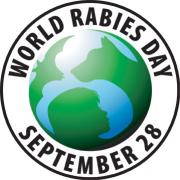#EndRabiesTogether

#EndRabiesTogether
September 28, 2015 is World Rabies Day. Rabies is a viral disease found on every continent in the world except Antarctica. Any warm blooded animal, including humans, can contract the disease through a bite from an infected animal. Mammals have the greatest susceptibility to rabies, and topping the list of animals serving as vectors for the transmission of rabies are foxes, skunks, bats, jackals and wolves, as well as domestic dogs and cats. Worldwide, dog bites are responsible for causing most cases of human rabies.
The Rabies Virus
All humans should fear rabies. This disease kills nearly 100% of those who contract it. A bite from an infected animal injects the rabies virus into the wound because large amounts of the virus are found in the saliva of an infected animal. The virus travels up the nerves to the spinal cord and finally into the brain. A dog with rabies was the protagonist in the Stephen King thriller Cujo. This St. Bernard was infected with rabies by a bat and began exhibiting the erratic and unusual behavior typical of rabies virus infection. Cujo became extremely aggressive and salivated excessively. Some dogs and cats with rabies develop paralysis and cannot close their mouths. Because the jaw and throat paralysis leads to inability to drink water, rabies is colloquially known as hydrophobia. Ultimately the virus kills all infected animals.
Vaccination Matters
Rabies can be prevented in animals by vaccination, thus eliminating the risk for humans. In the United States, before 1960, most cases of rabies occurred in domestic animals. Since vaccination of dogs and cats is now nearly universally required by law, most cases of rabies are seen in wildlife, especially foxes and bats. In Bangladesh, dog vaccination programs implemented since 2011 have dropped the rate of human death from rabies by 50%. Despite the high efficacy and safety of pet vaccines, rabies is the cause of death in 60,000 humans annually; most victims come from impoverished rural areas in Asia and Africa where dogs are not routinely vaccinated for rabies.
The Tremendous Cost of Protection
In the United States, human rabies is a rare diagnosis, but rarity comes at a cost of $300 million annually. The $300 million includes the cost of animal vaccination programs, rabies surveillance and treatment of people exposed to rabies through the bite of an unvaccinated companion animal or wildlife. Although the post bite treatment for rabies is 100% effective in preventing human rabies, vaccinating all pets against rabies would be safer for people and pets alike and certainly much less stressful. Imagine how you would feel if you were bitten by an unvaccinated animal and had to worry about exposure to a fatal disease!
#EndRabiesTogether
Pet families can do their part to celebrate World Rabies Day. Check with your veterinarian about your pets’ rabies vaccination status and update the vaccine if it has lapsed.



































